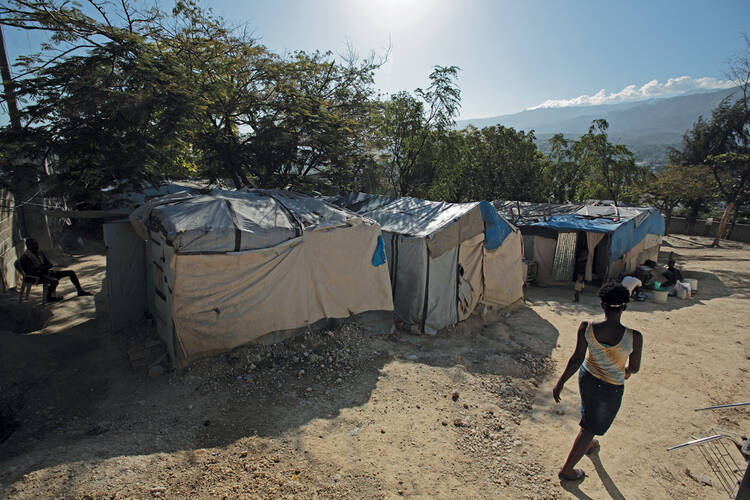Nearly five years after one of the most devastating earthquakes ever to rock the Western Hemisphere, more than 85,000 people still live in dozens of tent camps across Haiti’s expansive earthquake zone.
While significant, the number is small compared with the original 1.5 million people who were left homeless and dependent on international agencies for food and shelter in the weeks after the magnitude 7 temblor leveled much of the Haitian capital of Port-au-Prince and surrounding areas. The earthquake on Jan. 12, 2010, claimed 316,000 lives, according to the Haitian government. The number of people who remain homeless years after the disaster points to the continuing challenges facing the hemisphere’s poorest nation.
“Is Haiti getting better?” asked Darren Hercyk, country representative for Catholic Relief Services. “I can say yes, but it really depends on how people measure that.”
Hercyk, who has been in Haiti for two and a half years, cites new housing, an enhanced police presence, improved roads and better access to health care as signs that Haiti is overcoming the challenges that have plagued its 210-year history. For that he credits the Haitians working through numerous international partnerships.
“Haitians are not just at the center of these projects, but they are leading these projects,” he said.
The rebuilding of St. Francis de Sales Hospital is one of the most visible projects in the capital. During the weeks after the quake, physicians, nurses and volunteers treated hundreds of injured people in field tents set up in the hospital courtyard because much of the facility had been destroyed. Planning began in 2011 and has involved C.R.S., Catholic Health Association of the United States and the Port-au-Prince Archdiocese. The new hospital is scheduled to be dedicated on Jan. 15.
Beyond the hospital, there has been the task of rebuilding Catholic churches, schools and convents under the Partnership for Church Reconstruction in Haiti, or PROCHE. Juan Molina, a Trinitarian priest who is the director of the U.S. bishops’ office on Latin America, said PROCHE has distributed nearly $20 million for reconstruction projects through October.
Again, Father Molina explained, the emphasis has been on sharing responsibility between Haitian church leaders and U.S., German, Canadian and French church partners for the dozens of projects completed or underway.
Ted and Katharine Oswald, a husband-wife team who share the position of policy analyst and policy coordinator for the Mennonite Central Committee in Haiti, said that safe, affordable housing remains one of Haiti’s greatest needs. They expressed concern about the ongoing forced evictions from tent camps as property owners seek to reclaim vacant land.
“Saying 90 percent of people have vacated the camps is not a great representation of the true picture,” Ted Oswald said. The couple pointed to Canaan, a community of approximately 50,000 to 200,000 people on the outskirts of Port-au-Prince, where there are no roads, sanitary services or dependable water supply. Thousands of people have relocated to Canaan after leaving some of the tent camps and are no longer counted among those displaced by the earthquake.
Meanwhile, Haiti’s still-young democracy is fragile. Protests in late 2014 resulted in the resignation of Prime Minister Laurent Lamothe, and President Michel Martelly was addressing recommendations from a special commission he appointed to end an impasse over elections. Clashes have erupted in Port-au-Prince between pro-government and anti-government demonstrators. The national police have responded by firing tear gas to disperse the crowds.








